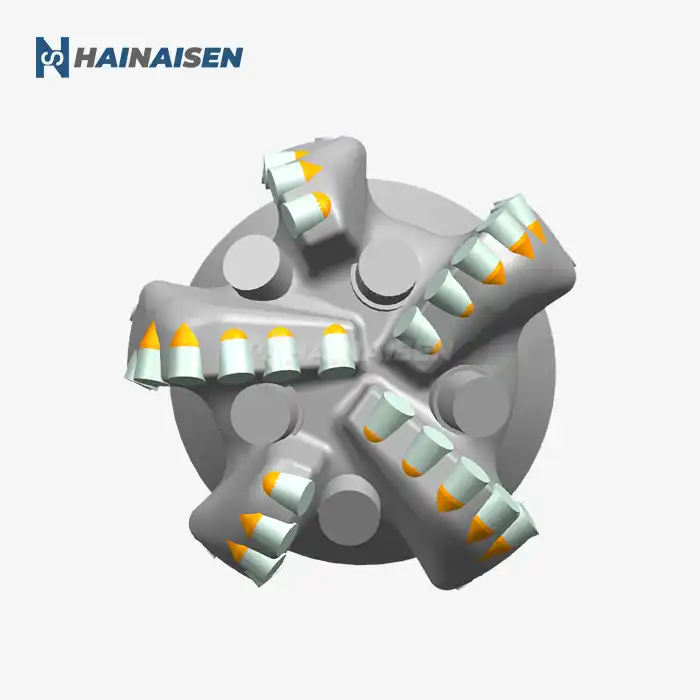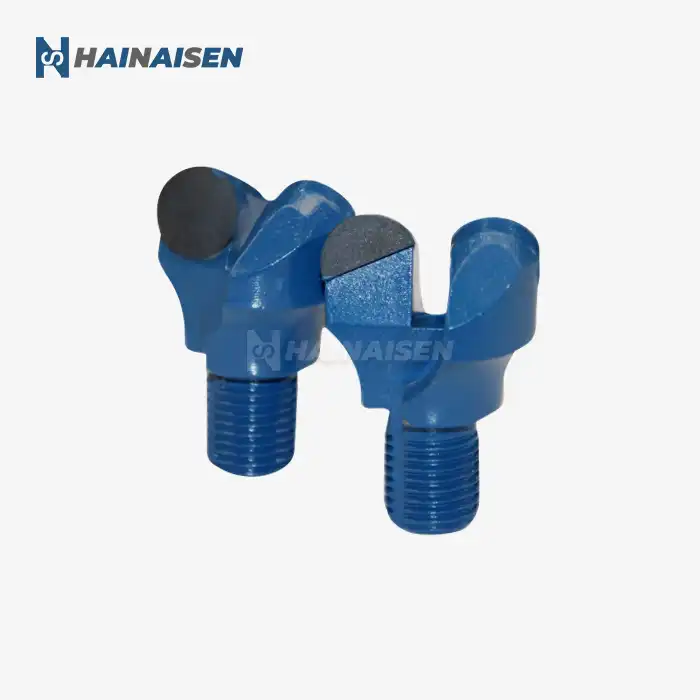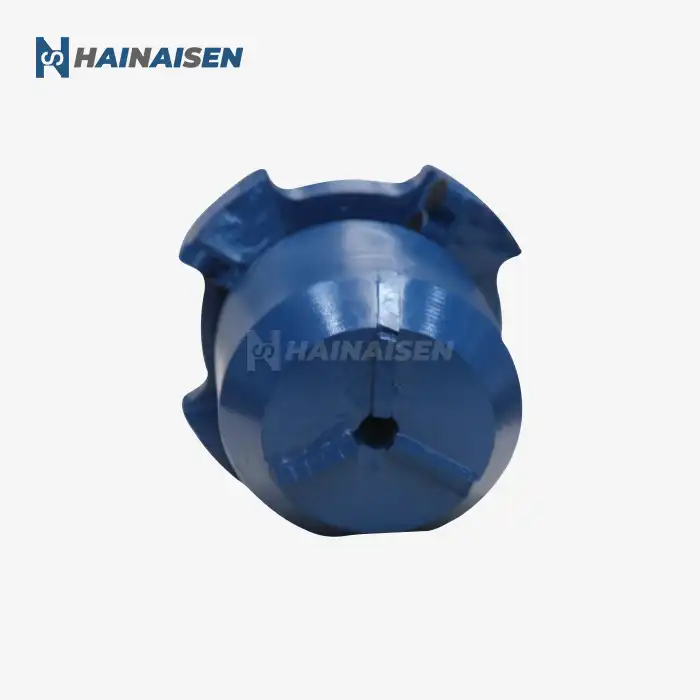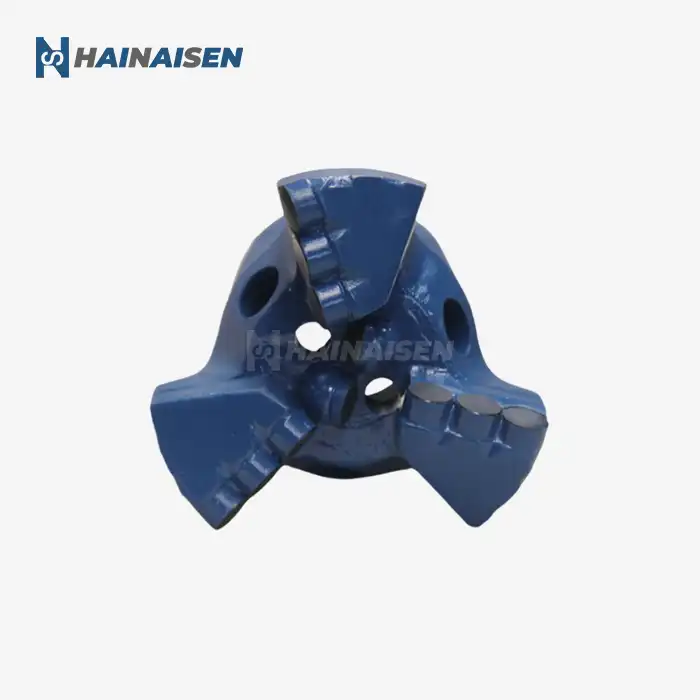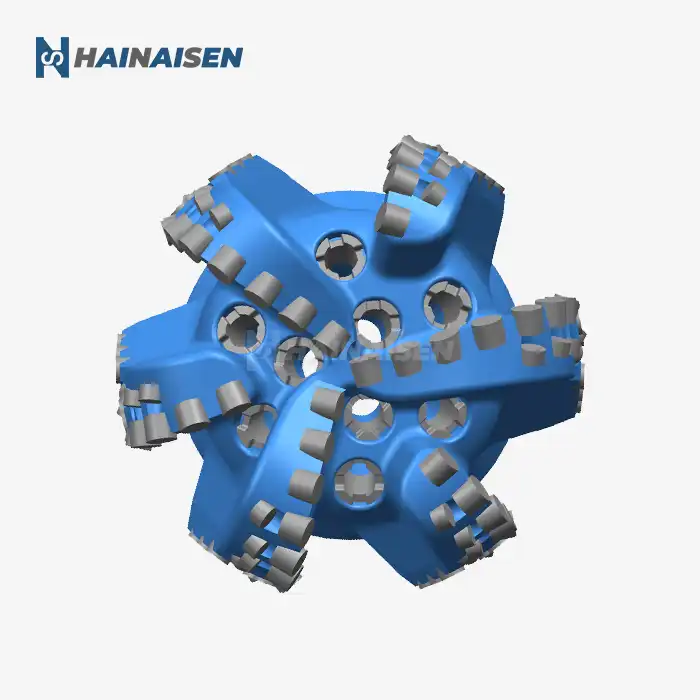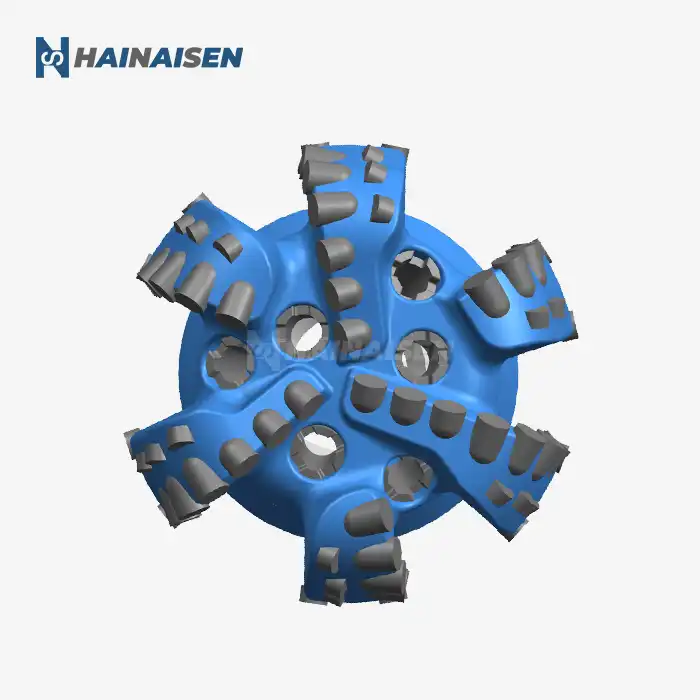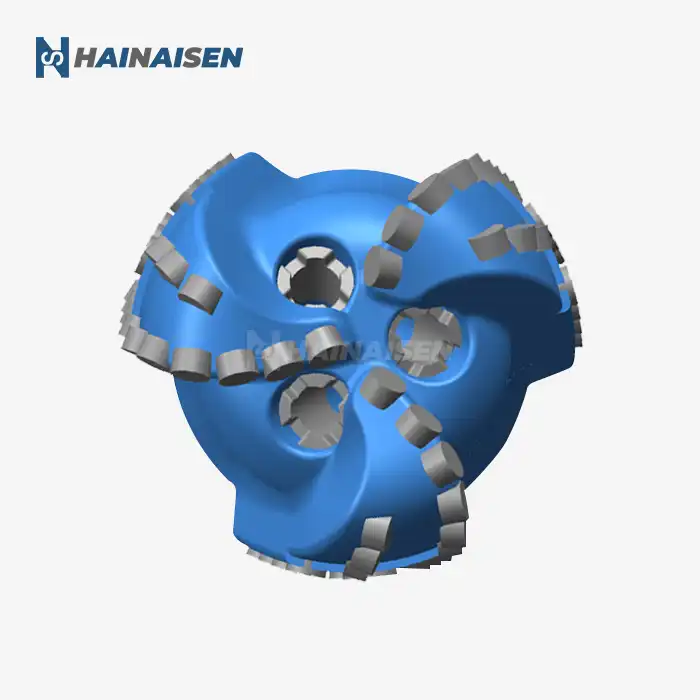Steel vs. Matrix: Comparing PDC Bit Body Materials
When it comes to PDC bit construction, the choice between steel and matrix body materials is crucial for determining the bit's performance and longevity. Each material offers distinct advantages and is suited to different drilling conditions.
Steel Body PDC Bits
Steel body PDC bits, like the 5 Blade Steel Body PDC Bit, are renowned for their robustness and impact resistance. The steel construction provides several key benefits:
- Enhanced Toughness: Steel bodies can withstand higher impact forces, making them ideal for drilling through interbedded formations or in directional drilling applications.
- Improved Heat Dissipation: The thermal conductivity of steel helps in efficiently dissipating heat generated during drilling, preserving the integrity of the PDC cutters.
- Greater Repairability: Steel bodies can be more easily repaired and refurbished, potentially extending the bit's operational life.
- Customization Flexibility: Steel allows for more intricate blade designs and cutter placements, enabling optimization for specific drilling conditions.
Matrix Body PDC Bits
Matrix body PDC bits, on the other hand, offer their own set of advantages:
- Superior Erosion Resistance: The tungsten carbide matrix material is highly resistant to erosion, particularly beneficial in abrasive formations.
- Enhanced Cutter Retention: The matrix material provides excellent brazing properties, ensuring secure attachment of PDC cutters.
- Improved Hydraulics: Matrix bodies allow for more complex and efficient hydraulic channels, enhancing cuttings evacuation.
- Better Performance in Soft Formations: The abrasion resistance of matrix bodies makes them particularly effective in soft, sticky formations.
While both materials have their merits, the steel body of the 5 Blade PDC Bit offers a balance of durability, impact resistance, and design flexibility that makes it well-suited for a wide range of drilling applications. The choice between steel and matrix ultimately depends on the specific drilling environment, formation characteristics, and operational requirements.

5 Blade Design: Optimizing Cutting Efficiency and Durability
The 5 Blade Steel Body PDC Bit represents a pinnacle in drilling technology, carefully engineered to maximize cutting efficiency while ensuring long-lasting durability. This innovative design incorporates several key features that contribute to its superior performance in various drilling conditions.
Blade Configuration and Cutting Structure
The five-blade configuration is strategically designed to optimize the bit's cutting action:
- Balanced Force Distribution: The five-blade layout ensures even distribution of cutting forces, reducing vibration and enhancing bit stability during operation.
- Optimized Cutter Placement: PDC cutters are precisely positioned on each blade to maximize rock removal efficiency and minimize cutter wear.
- Improved Hydraulics: The spacing between blades allows for efficient fluid flow, enhancing cuttings evacuation and cooling of the cutting structure.
- Enhanced Durability: The robust steel body construction supports the blade structure, providing resistance against impact and bending forces.
Cutting Efficiency Enhancements
Several design elements contribute to the bit's cutting efficiency:
- Variable Blade Height: The blades are engineered with varying heights to create an optimal cutting profile, ensuring efficient rock removal across the entire bit face.
- Customized Cutter Sizes: Different cutter sizes may be used across the bit face to optimize cutting action for specific formation types.
- Back Rake Angle Optimization: The back rake angles of the PDC cutters are carefully selected to balance aggressiveness and durability.
- Secondary Cutting Structure: Some designs incorporate backup cutters or wear knots to enhance durability and maintain ROP as the primary cutters wear.
The 5 Blade Steel Body PDC Bit design exemplifies the balance between cutting efficiency and durability. Its optimized blade configuration and cutting structure enable it to maintain high penetration rates while resisting wear, making it a versatile choice for various drilling applications. The bit's ability to operate at speeds ranging from 60 to 250 RPM and handle drilling pressures of 20 to 110 KN demonstrates its adaptability to different operational parameters.
Maintenance Tips: Extending the Life of Your PDC Bit
Proper maintenance is crucial for maximizing the lifespan and performance of a 5 Blade Steel Body PDC Bit. By following these maintenance tips, drilling operators can ensure optimal bit performance and longevity:
Pre-Run Inspection and Preparation
- Visual Inspection: Thoroughly examine the bit for any signs of damage, loose cutters, or irregularities before each run.
- Nozzle Check: Ensure all nozzles are clear and properly sized for the intended drilling parameters.
- Cutter Evaluation: Assess the condition of PDC cutters, checking for wear, chipping, or breakage.
- Thread Protection: Apply appropriate thread compound and ensure proper make-up torque to prevent damage during connection.
Operational Best Practices
Adhering to proper operational practices can significantly extend bit life:
- Parameter Optimization: Operate within the recommended speed (60-250 R/min) and drilling pressure (20-110 KN) ranges to prevent premature wear.
- Weight on Bit (WOB) Management: Gradually apply WOB when starting a new hole to allow the bit to stabilize and prevent impact damage.
- Rotary Speed Control: Maintain appropriate RPM to balance ROP and bit life, adjusting for formation changes.
- Hydraulics Management: Ensure proper flow rate (30-40 LPS) to maintain effective cuttings removal and bit cooling.
- Vibration Monitoring: Use downhole tools to monitor and mitigate harmful vibrations that can accelerate bit wear.
Post-Run Care and Analysis
After each run, proper care and analysis can inform future operations and extend bit life:
- Cleaning: Thoroughly clean the bit to remove all drilling fluid and formation material.
- Detailed Inspection: Conduct a comprehensive examination of the bit body, cutters, and hydraulic components.
- Wear Analysis: Document the wear patterns and cutter conditions to inform future bit selection and parameter adjustments.
- Refurbishment Evaluation: Assess the potential for bit refurbishment to extend its usable life.
- Storage: Store the bit properly in a clean, dry environment to prevent corrosion and damage when not in use.
By implementing these maintenance practices, operators can significantly enhance the performance and longevity of their 5 Blade Steel Body PDC Bit. Regular care and attention to operational parameters ensure that the bit maintains its cutting efficiency and structural integrity across multiple runs, ultimately leading to improved drilling economics and reduced downtime.
Conclusion
The 5 Blade Steel Body PDC Bit stands as a testament to advanced drilling technology, offering superior impact and wear resistance through its innovative design and material composition. By understanding the advantages of steel body construction, optimizing the five-blade configuration, and implementing proper maintenance practices, drilling operators can maximize the bit's performance and longevity across various applications.
For oil and gas companies, coal mining operations, and water well drilling teams seeking to enhance their drilling efficiency and reduce operational costs, the 5 Blade Steel Body PDC Bit presents a compelling solution. Its versatility in handling different formation types, from medium hardness to low compressive strength strata, makes it an ideal choice for a wide range of drilling projects.
At Shaanxi Hainaisen Petroleum Technology Co., Ltd., we specialize in delivering cutting-edge drilling solutions tailored to meet the unique challenges of your operations. Our team of experts is ready to assist you in selecting the right PDC bit for your specific needs, ensuring optimal performance and cost-effectiveness.
To learn more about how our 5 Blade Steel Body PDC Bit can revolutionize your drilling operations or to discuss custom bit designs, please don't hesitate to reach out. Contact us at postmaster@hnsdrillbit.com for personalized assistance and to explore how we can support your drilling success.
References
1. Smith, J.R., et al. (2022). "Advancements in PDC Bit Design for Enhanced Durability in Challenging Formations." Journal of Petroleum Technology, 74(5), 62-70.
2. Chen, D., & Williams, K. (2021). "Comparative Analysis of Steel vs. Matrix Body PDC Bits in High-Impact Drilling Environments." SPE Drilling & Completion, 36(2), 185-197.
3. Rodriguez, A.M., et al. (2023). "Optimizing Blade Configuration in PDC Bits for Improved Cutting Efficiency and Stability." International Journal of Rock Mechanics and Mining Sciences, 152, 104995.
4. Thompson, L.K., & Baker, R.O. (2020). "Best Practices in PDC Bit Maintenance and Performance Optimization." SPE Drilling Conference Proceedings, SPE-199722-MS.
5. Nguyen, T.H., et al. (2022). "Impact of PDC Bit Design on Drilling Efficiency in Medium Hardness Formations." Journal of Natural Gas Science and Engineering, 99, 104398.
6. Wilson, G.J., & Martinez, A. (2021). "Advances in Steel Body PDC Bit Technology for Extended Bit Life in Abrasive Formations." Offshore Technology Conference Proceedings, OTC-30828-MS.



